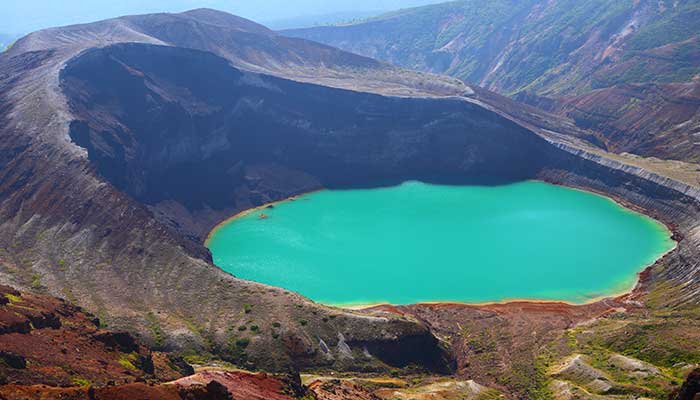
Crater lakes are formed as a result of meteor showers or volcanic eruptions, forging calderas on the surface of our Mother Earth that were eventually filled in with water.
Seven stupendous crater lakes from around the world have been shortlisted to offer an invaluable peek into the geological history of our planet.
Okama Lake, Japan
A complex volcanic eruption during the 18th century led to the formation of a natural crater in Japan. The Okama lake measures about 200 feet in depth and 1,200 feet in diameter. The lake is also known as ‘Five Color Pond’ as it alters its color depending upon the weather.
Lake Tritriva, Madagascar
Lake Tritriva is a volcanic lake encircled with steep cliff walls made of gneiss rock. The lake is located in the central highlands of Madagascar. The water of the emerald green lake is 160 meters deep. The sulfurous water of lake Tritriva prohibits visitors from swimming.
Pingualuit Lake, Canada
The Pingualuit Lake was formed during the Pleistocene when struck by a meteor at Quebec’s Ungava Peninsula. The crater lake remained undiscovered until the 1990s. The coring efforts of scientists from Laval University revealed that the samples of sediments collected from the lake are from two glacial periods at least.
Segara Anak, Indonesia
Segara Anak is a magnificent crescent-shaped lake that was forged after a violent eruption tore down Mount Rinjani in 1257 A.D. The Volcanic Explosivity Index of the eruption is estimated to have had a massive measure of 7. It is speculated by some scientists that the eruption may have been a trigger of the Little Ice Age.
Crater lake of Mount Katmai, Alaska
Mount Katmai in southern Alaska is an enormous stratovolcano, with a diameter of 10 km. In 1912, the Novarupta eruption formed a caldera in the center of the mountain. The floor of the caldera is about 3,400 ft in elevation.
Kaali Lake, Estonia
The Kaali lake in Estonia is one of the eight sibling craters that were forged by violent meteor showers, which is estimated to have occurred between 4,000 and 7,600 years ago. The energy of the meteor shower is believed to have been brutal and is often compared to the atomic bombing of Hiroshima in 1945.
Kelimutu Crater Lake, Indonesia
Kelimutu volcano constitutes three striking depressions at the summit with three lakes having varying colors. The westernmost lake of the three, Tiwu Ata Mbupu is generally blue, while the other two lakes Tiwu Ata Polo and Tiwu Nuwa Muri Koo Fai are segregated by a shared crater wall and are red and green respectively.
Which crater lake do you think has the most impressive geological history?